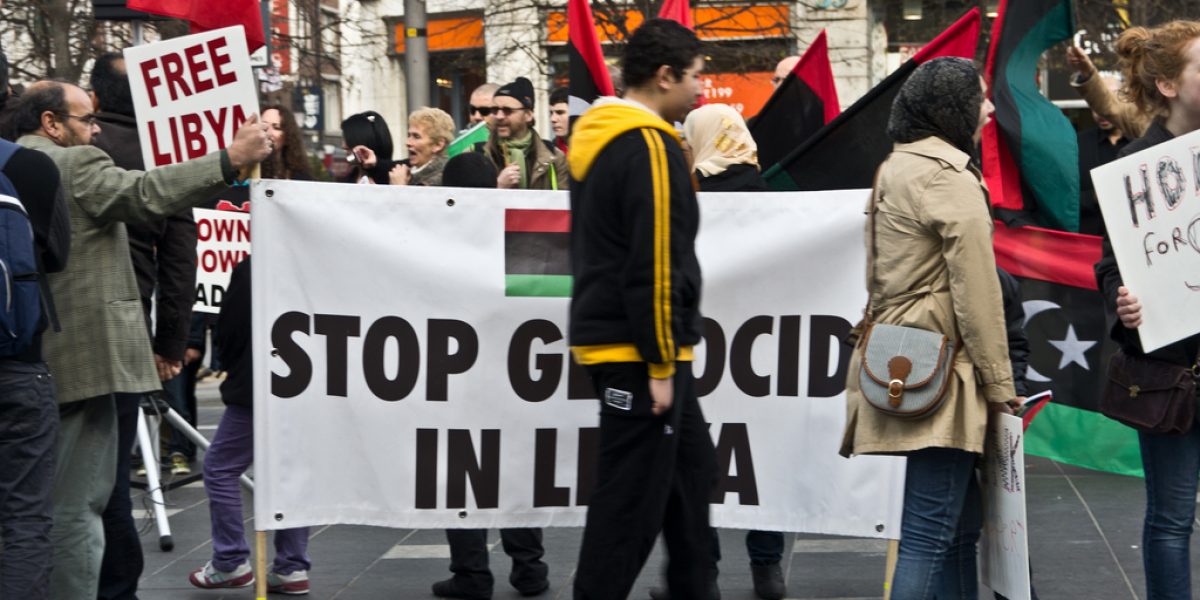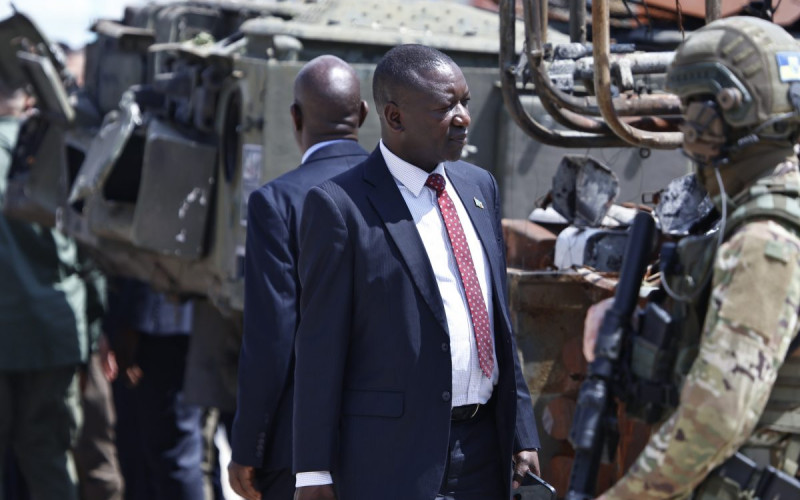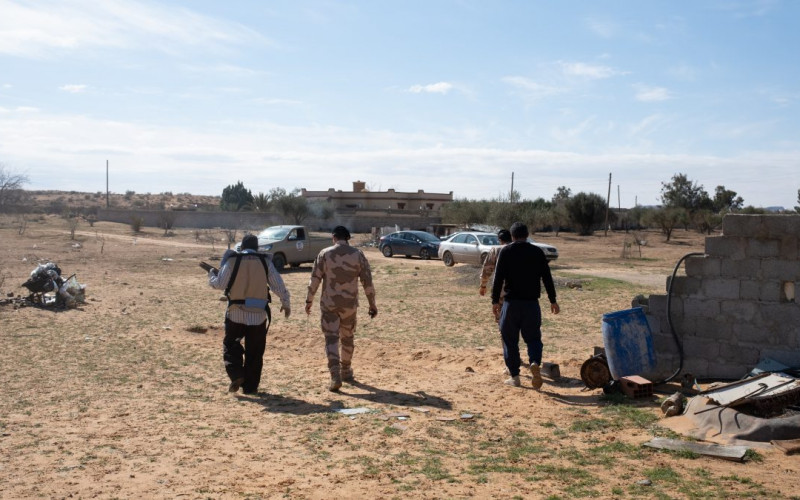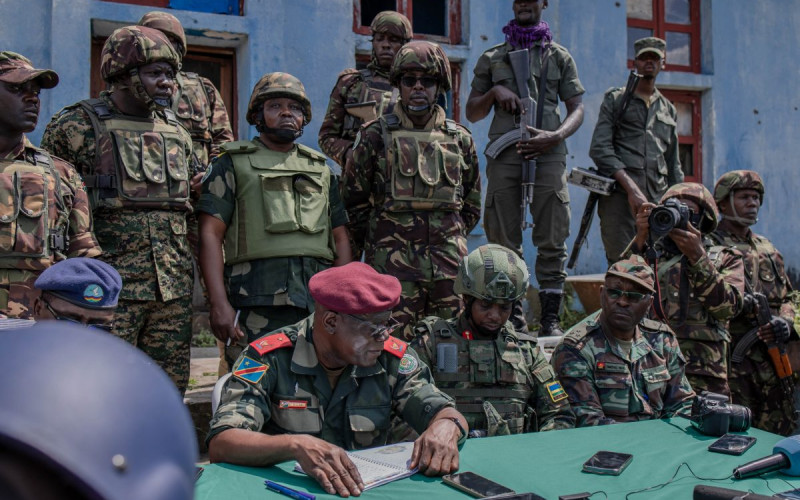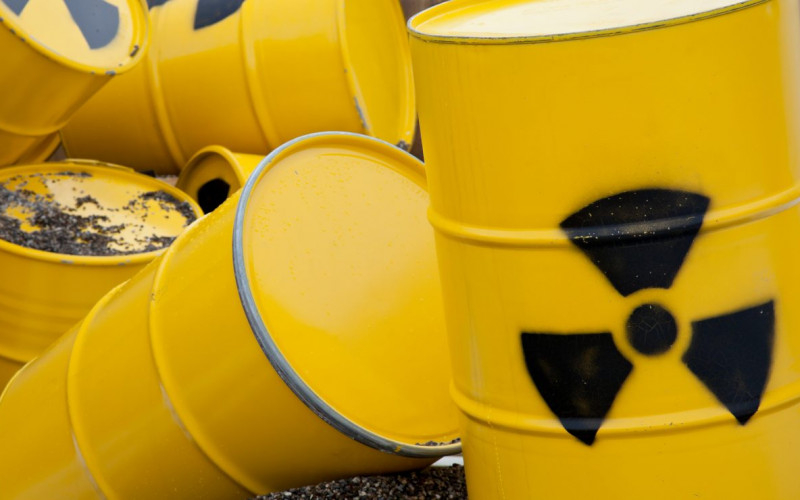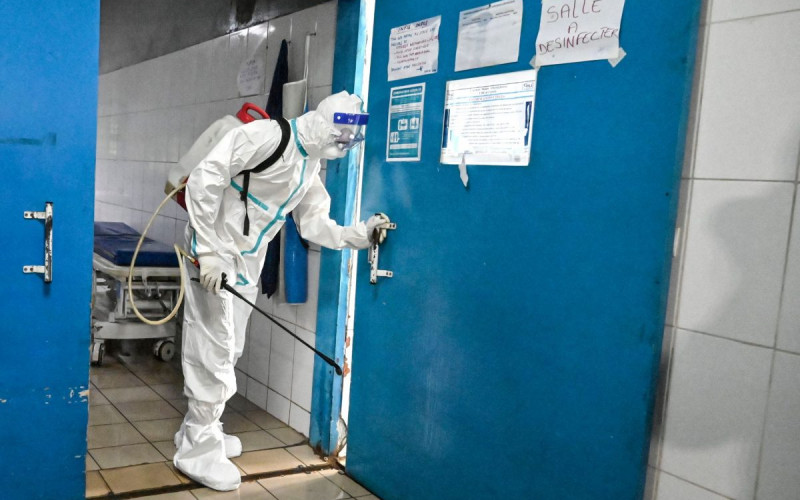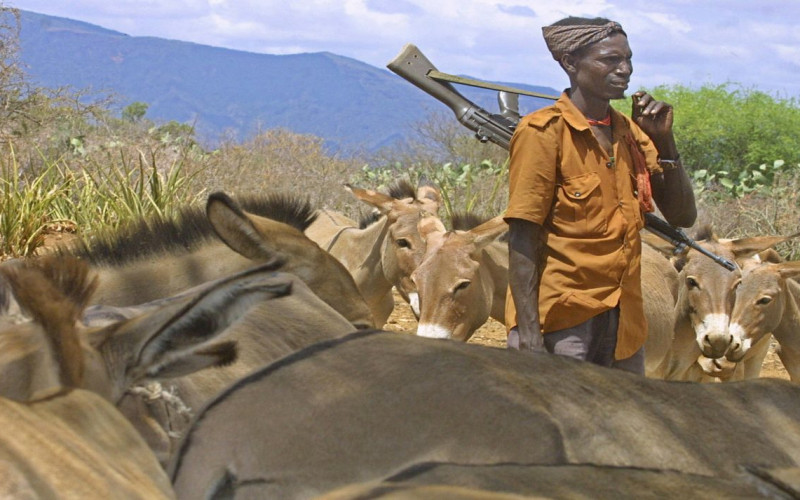This special SAIIA feature addresses a series of inter-related internal, regional, and international security and political implications of developments in the country.
With the death on 20 October of Muammar Gaddafi, Libya enters a new and precarious phase. This special SAIIA feature addresses a series of inter-related internal, regional, and international security and political implications of developments in the country.
Internal challenges
In order to assess the possible internal security threats that may appear in Libya it is necessary to understand the NTC’s vision of the political process.
Intended political process
|
The NTC recently elected Abdurrahim El Keib as new interim Prime Minister. He is expected to announce his new cabinet during the next few weeks. The most contentious portfolios El Keib will have to fill include those of Finance, Oil, Defence, and Interior. The NTC vision of the whole transition could translate into a two year process that may drag on much longer depending on the ability of the transitional government to manage an open, inclusive and transparent political transformation process.
Key to the management of the transition will be how the NTC navigates power relations between tribes, political organisations, and militias. NTC fighters were unified during the fight against the Gaddafi government but come from various tribal, regional, and political backgrounds. The main challenge the NTC faces in the short to medium term is to maintain control over armed groups. This will be complicated by battles for political positioning in the new transitional government. Already some Islamic leaders such as Abdel Hakim Belhadj have indicated that militias will not lay down arms until their political power demands for representation in the NTC have been met. Belhadj was the leader of the Libyan Islamic Fighting Group (LIFG) in Afghanistan, and is an experienced mujaheddin commander that fought alongside al Qaeda and the Taliban. Belhadj left Afghanistan after the fall of the Taliban; later he was arrested in Malaysia and questioned by the CIA. He was also the target of a rendition operation that brought him to Libya where he was jailed together with 1,800 LIFG members from 2004 until 2010.
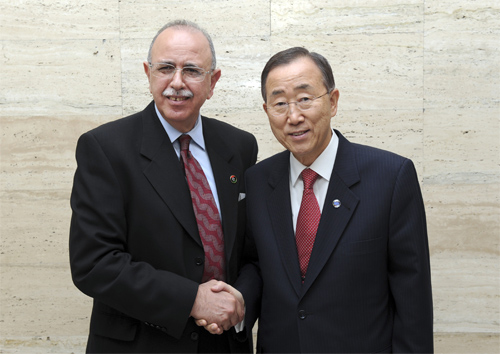
Image, above: Interim Libyan Prime Minister, Abdurrahim El Keib with United Nations Secretary-General, Ban Ki-moon. © UN Photo/Evan Schneider/4 November 2011
In any conflict, weapons mean power; the US has already invested millions of dollars to assist with the search for missing weapons stockpiles. 20, 000 shoulder fired ground-to-air missile systems have gone missing from stockpiles since the onset of the conflict; nine Libyan teams are operating with one American observer per team. The proliferation of arms during the conflict, and the threat of looting existing arms caches, implies that the disarmament, demobilisation and reintegration of rebel fighters and civilians may become highly politicised if leaders of rebel factions feel their political demands are not heard by the NTC leadership.
It is unclear to what extent so-called ‘hard-line’ Gaddafi supporters will give up the fight. Groups may emerge that use terror or other tactics to destabilise the political process. At the level of governance it is furthermore unclear what basic policing, and intelligence capacity remains to safeguard what is left of the state. If the NTC does not manage volatile power relations well during this transition phase, disaffected groups and individuals may see Muammar Gaddafi as martyr of a Western-led intervention in the country. Previous divisions between Gaddafi hardliners and Islamic extremists can be wiped out by the establishment of a common threat, namely Western intervention. A weak transitional government could be threatened if these two groups cooperate: not because they are ideologically aligned, but because they have a common interest to destabilise Tripoli.
A further source of conflict could emerge in the context of managing oil revenues. Libya’s oil fields are mostly located in the east. Some analysts have already indicated that grievances regarding distribution of oil revenues may spur elements in the east to think that secession from Libya is an option. The immediate threat of such a move is relatively low. However, the NTC and a new interim government will have to give due consideration to the distribution of oil revenues and resource rents in order to prevent grievances from emerging. Libya has the largest oil reserves, estimated at 41.5 billion barrels, in Africa. Oil revenues bolstered the Gaddafi regime, and enabled the leader to obtain a significant level of regional political influence. The internal battle for a share of oil revenues, as well as external pressure to access this lucrative resource, will have to be carefully monitored. In 2010, before the conflict, Libya produced 1.5m barrels per day.
Regional impact
The security impact of the Libyan crisis on the region has many dimensions. At a humanitarian level more than a million Libyans fled the country in the months since the civil war broke out. Tunisia, Egypt, and Italy have been affected by these refugee flows. The displacement of migrant workers from several African countries is also a notable regional impact, especially in Niger. The return to Niger of tens of thousands of migrant labourers, as well as Tuareg fighters trained and equipped by Gaddafi has raised questions as to what new demands these groups may make of the Niger regime. In the past Gaddafi supported some Tuareg groups in their struggles with regimes in both Mali and Niger. These refugee and migrant flows in the Sahel compound socio-economic problems in a region that suffers near chronic food insecurity. Ten million people were at risk of hunger, and one in five children chronically malnourished in the Sahel region during 2010, according to the World Food Programme and the UN Children’s Fund.
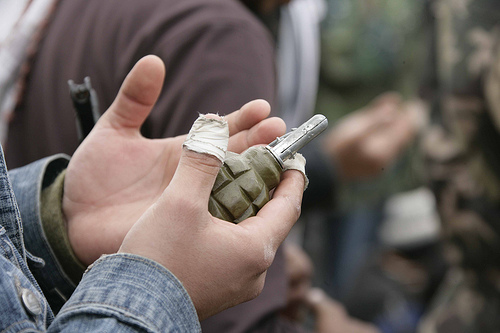
Image, right: A rebel fighter holds a hand grenade during heavy shelling by forces loyal to former Libyan leader Muammar Gaddafi near Bin Jawad. © Nasser Nouri/Flickr/Creative Commons/5 March 2011
Further danger zones where Libyan arms could pose a distinct threat are Chad (where the government has been fighting several small and larger rebel- and insurgent groups) and Darfur. The strength of AQIM, and the real danger this group poses to regional security remains debatable. But, as seen in Afghanistan and Somalia, internal conflict combined with weak institutional and state security capacity, create conditions wherein such groups can act and organise without much restraint.
The security of the Libyan regime under Gaddafi brought some sort of stability to the troubled Northern parts of Chad in the last few years. N’Djamena is rightfully concerned about future relations with Libya because of their support for Gaddafi at the start of the conflict. The presence of Chadian mercenaries among pro-Gaddafi forces could also strain relations. Like the people of Niger, Chadians have been dependant on migrant work in Libya for many years; it is not clear how open the NTC will be to their return to Libya. By June 2011 it was estimated that nearly 43,000 Chadians had returned home from Libya. The crisis in Libya also led to a 57% reduction in the flow of remittances from Libya to Chad, pushing families that have been dependent on this as a source of income into poverty and a food crisis. The proliferation of arms will also pose a problem for the Chadian government because many mercenaries have returned to Chad with weapons and without prospects of a future in a country struggling with poverty and unemployment.
These factors pose a direct challenge to the AU Peace & Security Council. Instability in Libya will also impact on Algeria, a country which has had to deal with its own internal conflicts and radical Islamic organisations. The critical question the AU confronts is how best to respond to the proliferation of weapons, and the fact that conflict in Libya has effectively undercut regional security.
International & Geopolitical implications
The Libyan crisis sparked a controversy regarding humanitarian intervention in the context of R2P. The AU described it as an African problem; the French and Italians described it as a Mediterranean problem; the British and the Americans described it as an international problem; while the Arab League felt that it was a “spill over Arab” problem.
All of the above are correct to some extent. However, whether for good or bad, the United Nations Security Council (UNSC) authorisation to impose a no fly zone over Libya was an essential part of the international response to the unfolding political crisis in Libya. The AU’s response to the crisis was perceived as weak, regardless of the fact that it had tabled its African Roadmap before UNSC resolution 1973 was implemented. Another problem the AU confronted was that although Gaddafi agreed not to participate in negotiations with rebels, the rebels were not too eager to negotiate a peaceful settlement. The AU wanted, at all costs, to prevent internal conflict from spreading. This explains why the AU constantly emphasised that only diplomacy and dialogue can resolve the political stand-off.
The question therefore arises: what next step could the AU have taken after suggesting the Roadmap? The AU could not have ramped up its intervention to a military mission due to the simple fact that the African Standby Force remains nothing but a paper tiger. However, in hindsight it can be argued that an African military intervention could have been the next step if the continent had its own intervention force. This means that South Africa and the AU should take two critical lessons from the Libyan crisis. Firstly, they need to interrogate the reasons why the AU push for a diplomatic and mediated settlement did not succeed (taking all internal and external variables and actors into account); and secondly, in the long term they need to ensure that the AU has an operationally deployable African Standby Force at its disposal to complement African mediation efforts with the threat of force in cases where mediation and negotiation fail.
Strategically the fall of the Gaddafi regime could favour South Africa. The ‘big five’ on the continent have now been reduced to the ‘big four’: SA, Egypt, Algeria and Nigeria. More importantly, it has removed from the AU a leader with very eccentric expectations of how the AU should be structured. This provides South Africa with an opportunity to act more boldly on the AU’s Peace and Security mechanism, making use of its existing soft power capabilities (that have been successful in Africa), and combine it with a multi-lateral force that could be deployed to protect civilians, and enforce the terms of peace in future intra-state conflicts.
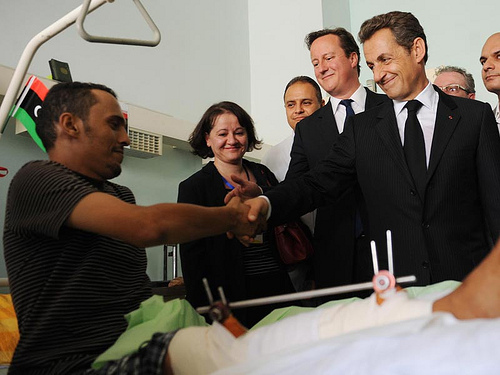
Image, right: United Kingdom Prime Minister David Cameron and French President Nicolas Sarkozy visit a hospital in Tripoli during their visit to Libya. © The Prime Ministers Office/Flickr Photostream/Creative Commons/15-September 2011.
Due to the Arab League’s endorsement of UNSC resolution 1973, it will also be important to assess the shift in regional alliances this could imply: Gaddafi was a thorn in the side of GCC countries, particularly Saudi Arabia. Due to a long and tricky internal transition process, it is unclear how these external actors will influence a new Libyan regime, but, with Gaddafi out of the way, it is to be expected that countries that backed the rebel effort to oust Gaddafi may in the long term be well positioned to influence and alter the regional (post-Gaddafi) balance of power.
A crucial issue to monitor is AFRICOM (the US operated the Wheelus air force base outside Tripoli from WWII, until the 1969 coup that brought Muammar Gaddafi to power). Since AFRICOM’s creation there have been several intense debates regarding its future physical presence on the continent. It is still headquartered in Germany. It will be necessary to monitor advances France, the US, and UK make in terms of military deployments, covert operations, and the establishment of permanent military bases in the country.
Implications for South Africa
After the death of Muammar Gaddafi, NATO decided to call a halt to its operations over the country. Only time will tell whether the NTC can establish a vision of the ‘new Libya,’ and thus steer the country through the treacherous process of establishing a democratic order. Can South Africa, with its much touted credentials as an example of a (relatively) peaceful transition to democracy, play a constructive role in Libya? In order to answer the latter question it is necessary to ask what South Africa’s national interest in Libya is: is it oil, access to a possible export market or a strategic security partnership? Libya is far removed from South Africa’s direct sphere of regional influence. Yet, the transition taking place in Libya may be a golden opportunity for South Africa to establish closer ties with the NTC. Such ties could be developed on the basis of South African technical advice and support to elections and constitution making processes the country is about to embark on. In order for South Africa to develop a close relationship with Libya much hard work will have to be done to counter the perception inside Libya that South Africa and the AU were unwilling to act against Gaddafi.
The internal stability of Libya will have a lasting effect on North Africa, the Mediterranean and the Arab world. Libya’s strategic importance derives from its geographic position and its abundance of high quality oil. Libya’s security has a direct effect on the rest of the region’s stability, and is potentially a counterpoise to extremism in North Africa. It is for these reasons crucial for South Africa to ensure that Libya is retained as a strong contributing state in the AU. Libya needs to be retained as an African partner, and should not be lost to the EU or the US.
It is in the interest of South Africa to be part of the rebuilding of Libya; this will give South African organisations a foothold in North Africa. During 2012 the Department of International Relations and Cooperation will launch the South African Development Partnership Agency. This agency could be more than an instrument of soft power in Libya. It can facilitate post-conflict reconstruction efforts while facilitating and building relationships with the crop of new leaders that are bound to emerge in the transition process. South Africa’s experience with institutional capacity development (such as in Southern Sudan), and its clout as an economic power on the continent, could prove valuable in designing a radically new policy approach to the post-Gaddafi Libya.

